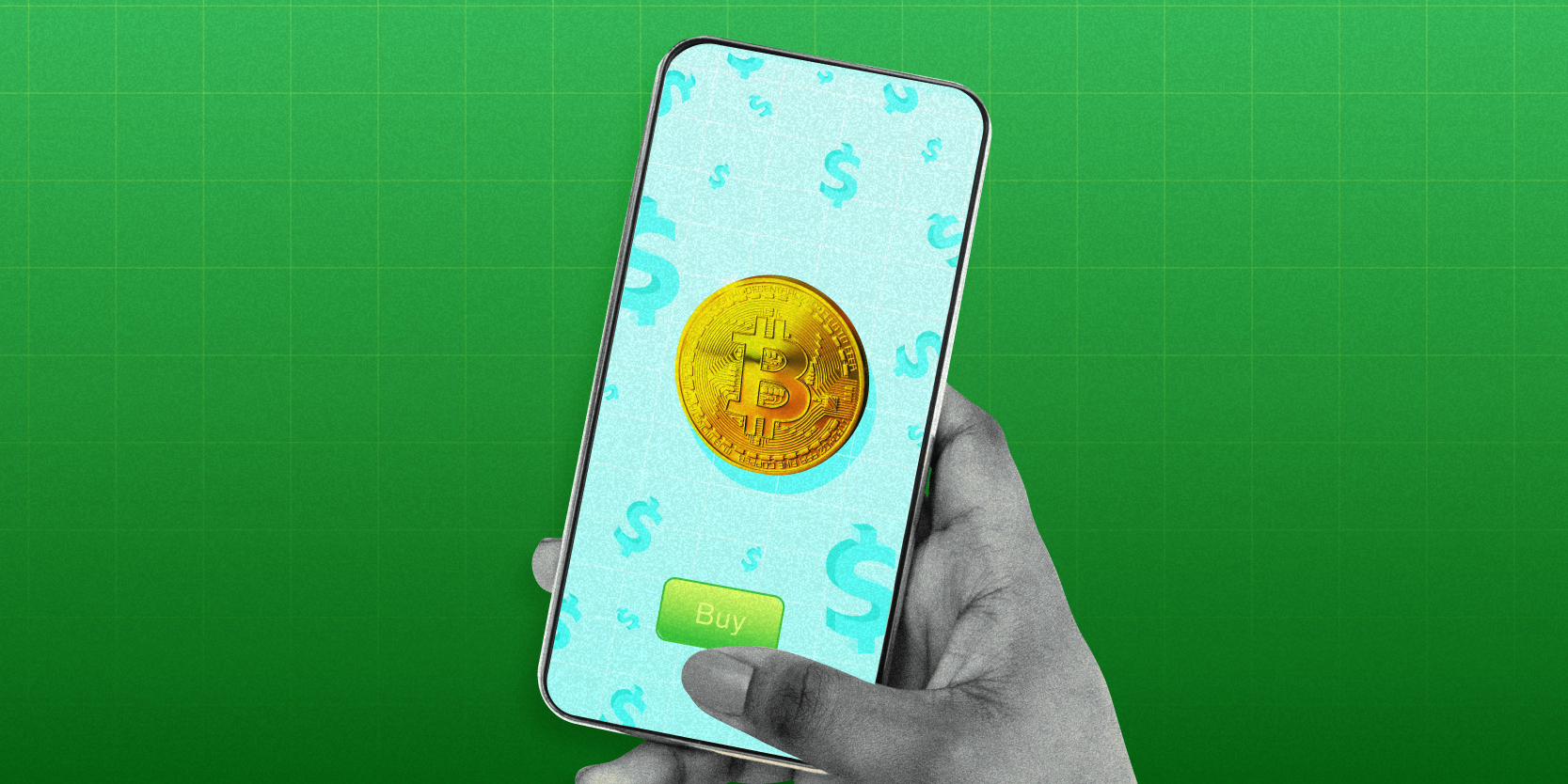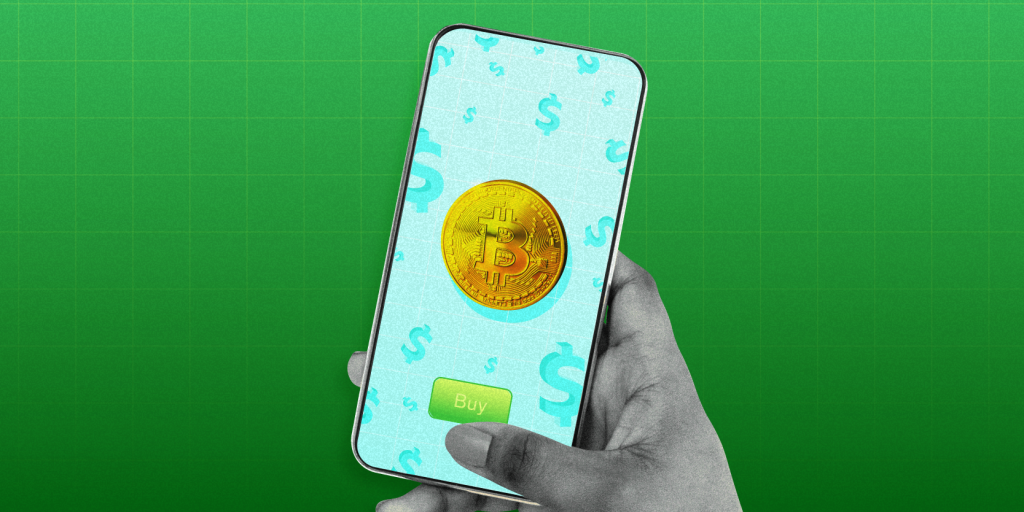
Alyssa Powell/Insider
- Bitcoin investing involves choosing an exchange, verifying your identity, and withdrawing to a wallet.
- Investing in bitcoin is risky since it's a volatile and speculative asset.
- Experts recommend using a buy-and-hold strategy when buying bitcoin, in order to average out rises and falls.
- Visit Insider's Investing Reference library for more stories.
More than a decade into its existence, Bitcoin doesn't seem to be going away. The cryptocurrency has attracted good and bad headlines as it's worked its way through multiple peaks over the years, and despite a reputation for volatility, it continues to attract new investors with its promise of market-beating returns.
Here's what to know about investing in Bitcoin.
What to know about Bitcoin
Bitcoin is a cryptocurrency. This means it's a form of electronic money that secures and validates transactions via the use of cryptography. In Bitcoin's case, people and organizations known as "miners" use computing hardware to calculate a code – known as a "hash" – that encrypts the data contained in transactions. This data is collected into "blocks," which are linked together in a blockchain that cannot, in theory, be changed once written.
On an economic level, Bitcoin's creator – the pseudonymous Satoshi Nakamoto – created it in 2008 as a form of "sound money," akin to digital gold.
"What makes Bitcoin so special is that it has a finite supply of 21 million coins, with only a couple million left to be mined," explains Edward Moya, chief market strategist at OANDA's MarketPulse. "Simple supply and demand for Bitcoin is the main reason why prices have skyrocketed over the past year."
Despite having a fixed maximum supply, Bitcoin has shown remarkable volatility throughout most of its life with major fluctuations in its price.
Such swings make Bitcoin a highly speculative asset, one that should be considered only by traders willing to stomach a fair amount of risk. That said, at least some analysts suspect that its volatility will gradually decline over time, as its market grows and reduces its destabilizing reliance on leverage.
Step 1: Choose a crypto exchange
For most people, the best place to buy Bitcoin is on a crypto exchange. These are online platforms dedicated to facilitating trades in cryptocurrency, usually by offering trading pairs (e.g., USD to Bitcoin) and usually by matching buyers with sellers.
In the US, the leading crypto exchange by volume and customer base is Coinbase. That said, other reputable - and regulated - crypto-exchanges include Kraken, Gemini, eToro, and Crypto.com.
More inexperienced traders may wish to try a more general trading platform such as Robinhood. These have the benefit of being more user-friendly than the average crypto exchange, although their major downside is that many don't let users withdraw their bitcoin.
Step 2: Choose a payment method
Exchanges also vary in terms of the payment methods they support. Most major platforms do offer the option of linking your bank account for wire and ACH transfers, as well as the option of linking a debit card. Some also let you pay via PayPal, with Coinbase also supporting Apple Pay.
Regardless of the option you choose, you will have to verify your identity when first signing up for an account and registering a payment method. In the US, you're usually required to submit a scan of a state-issued ID, such as a driver's license or identification card.
Depending on where you are and on your chosen platform, you may also be required to provide scans of additional documentation (such as your passport), as well as being asked to submit a proof of address.
Step 3: Place your order
Once you're verified and have deposited cash into your account, you can then begin buying Bitcoin. This process varies according to the exchange you use, with some exchanges offering a process that simply involves clicking a Buy or Sell button and then specifying how much Bitcoin you want to buy (or sell).
In general, most crypto exchanges offer at least three basic order types:
- Market order: the option to choose if you simply want to buy Bitcoin at its current price. This type of order is usually completed in a matter of seconds, depending on the time of day.
- Stop order: an order where you specify the price at which you will buy or sell Bitcoin. This type is good if you want to make sure you sell Bitcoin before it falls too sharply. This type of order can take some time to execute, depending on how quickly the market moves.
- Limit order: instructs the exchange to execute a buy or sell order at a specific price or better. In contrast to stop orders, limit orders are visible to the market and can take longer to fill.
Again, executing any one of these options usually involves clicking a Buy, Trade, or New order button on an exchange's home screen. You'll then be able to choose from the above three (and more advanced) options, before clicking a Submit button or something equivalent.
Step 4: Store your crypto in a safe place
While bigger exchanges are becoming safer, hacks and fraud remain a big problem for the industry. This is why investors with significant sums in Bitcoin are advised to consider storing their cryptocurrency themselves.
"Experienced traders that are very good with cybersecurity might prefer to own their wallets, as this gives you the ability to move your cryptocurrencies whenever you want to and not be subject to an exchange. The saying 'Not your keys, not your coins' was popular last year, as many exchanges got hacked or shut down," says Moya.
This means transferring your Bitcoin from the exchange you use to your own cryptocurrency wallet. Such wallets come in two forms:
- Cold wallets: also known as hardware wallets, these are small devices that store your Bitcoin address' private key, which is necessary to transfer Bitcoin out of the address. They do not connect to the internet and are therefore considered safer than online, software-based alternatives.
- Hot wallets: also known as software wallets, these are apps that can be used through your phone, desktop computer, or web browser. They also store the private key of your Bitcoin address, but because they do connect to the internet, they aren't considered quite as safe as hardware/cold wallets.
Software wallets aren't quite as secure as hardware wallets, but the leading varieties do still offer a range of security features, such as two-factor authentication and compatibility with hardware wallets.
Selling bitcoin
While many traders turn to Bitcoin in the hope of making big money fast, pretty much every analyst advocates a long-term, buy-and-hold strategy. This is largely because holding for a longer period of time tends to average out gains and losses, providing a greater probability of a significant positive return by the time you sell your Bitcoin.
"In my opinion, it is better to buy and hold, perhaps allocating a small portion of your portfolio to cryptocurrencies, focusing on the ones typically held by institutional investors, such as Bitcoin and Ethereum at the moment," says Nikolaos Panigirtzoglou, an analyst at JPMorgan Chase & Co.
Likewise, many analysts also recommend adopting a dollar-cost-averaging (DCA) strategy, largely because this is another way of averaging out peaks and troughs.
"The best strategy for newcomers would be to [trade] Bitcoin on the DCA approach [...] you'll just buy a tiny bit on a monthly or weekly basis, not looking at the price movements at all," says Michaël van de Poppe, the CEO and founder of cryptocurrency consultancy, Eight.
However, Moya warns that even with a long-term hold strategy, new traders are generally advised to enter the world of Bitcoin investing with the mindset that they could lose most of their money.
"A new investor should only apply a very low, single-digit percentage of their trading portfolio to cryptocurrencies. Despite the many bullish calls for Bitcoin or Ethereum, massive plunges have happened in minutes. New investors may want to consider buying and holding a basket of cryptocurrencies, with an approach of scaling into positions," he says.
A longer-term approach is also beneficial from a tax perspective, since Bitcoin is classified as property in the US, and therefore liable to capital gains tax when sold.
The financial takeaway
Bitcoin is an interesting and exciting technological innovation, representing a form of decentralized electronic money that doesn't require a central authority (such as the Federal Reserve) to operate. It's also exciting from an investment perspective, with its high annual returns (in most years) making it one of the best-performing assets of the past decade, even if its volatility means it has suffered more than a few dramatic falls.
While investing in Bitcoin may seem complicated, starting off is as simple as picking a reputable exchange and setting up an account. Once you've verified your identity and deposited some money, you're then good to go, with most exchanges offering a range of order types in addition to the ability to simply buy Bitcoin.
When you've acquired a significant sum of Bitcoin, most experts recommend withdrawing it to your own cold (i.e., hardware) wallet. They also recommend a buy-and-hold strategy, so that you can iron out market dips and also avoid having your profits taxed as ordinary income.
